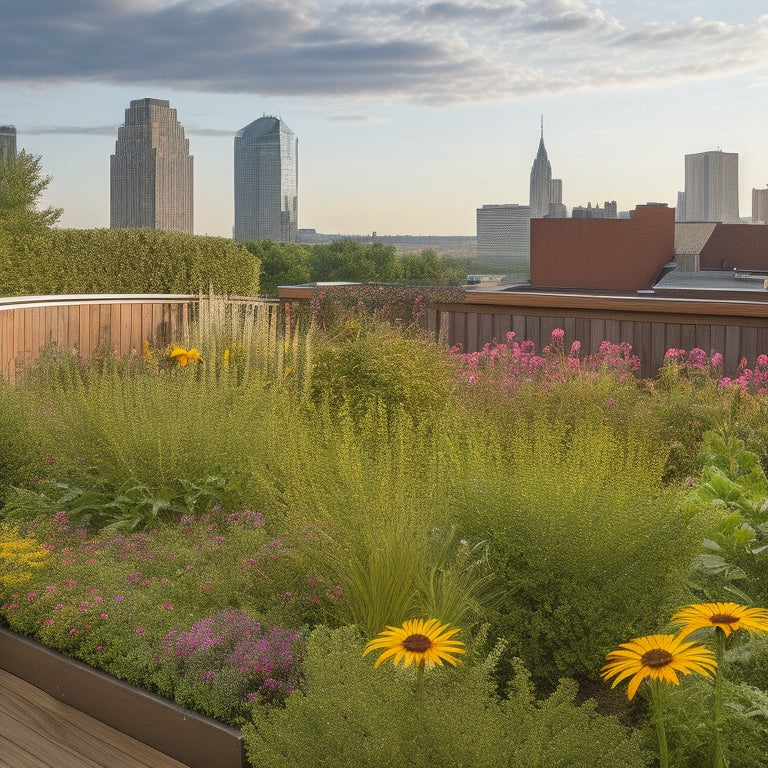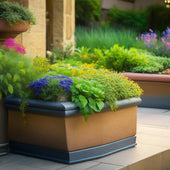
Native Plants for Rooftop Gardens: A How-To Guide
Share
You're about to transform your rooftop into a thriving oasis by harnessing the unique benefits of native plants, carefully selected to mimic the local ecosystem and flourish in the rooftop microclimate. Start by evaluating your site's sunlight exposure, wind direction, and weight-bearing capacity to make sure the right conditions for your plants. Then, choose native plants optimized for your climate zone, soil composition, and sun exposure. Consider rooftop-specific soil, drainage, and irrigation systems tailored to your plants' needs. With the right design, planting, and maintenance strategies, you'll be on your way to creating a sustainable, biodiverse ecosystem that benefits both you and the environment - and that's just the beginning.
Assessing Your Rooftop Garden Site
Before selecting indigenous plants for your rooftop garden, evaluate your site's specific conditions, including the amount of sunlight it receives, wind direction, and weight-bearing capacity. This thorough site assessment will guarantee that your chosen plants thrive in their new environment.
Consider the orientation of your rooftop and how it influences the amount of sunlight your garden will receive. Will it be full sun, partial shade, or a combination of both? Also, take note of the wind direction and speed, as this can affect plant growth and stability.
Rooftop accessibility is another vital factor to assess. Consider the ease of access to your rooftop, including the availability of stairs, elevators, or ladders. Will you need to transport heavy planters, soil, or other materials to the rooftop? Make sure that your rooftop can support the weight of your garden, including the plants, soil, and any hardscaping features.
Choosing the Right Native Plants
When selecting native plants for your rooftop garden, you'll need to ponder several key factors to make sure the plants thrive.
You'll want to contemplate the specific climate zone you're in, as well as the soil preferences of the plants you're interested in.
Climate Zone Considerations
You'll need to select native plants adapted to your rooftop garden's specific climate zone, as this determines the plants' hardiness and ability to thrive in local temperature and precipitation conditions.
Plant adaptation to your rooftop's microclimates is essential, considering factors like wind direction, humidity, and temperature fluctuations. Since rooftop gardens often experience unique microclimates, you'll need to choose plants that can tolerate these conditions.
When selecting native plants, consider your rooftop's soil composition and sun exposure. Does your rooftop receive full sun, partial shade, or a mix of both? Are your soil conditions sandy, loamy, or clay-based?
Understanding these factors will help you choose plants that thrive in your specific environment. For example, if your rooftop receives full sun and has sandy soil, you may opt for drought-tolerant plants like succulents or grasses.
Conversely, if your rooftop is partially shaded with clay-based soil, you may choose plants like ferns or wildflowers that prefer moist conditions. By considering these climate zone factors, you'll be able to create a thriving rooftop garden that's well-suited to your local environment.
Plant Soil Preferences
As you narrow down your native plant selection, consider the specific soil preferences of each species, since even small variations in soil composition can greatly impact a plant's ability to thrive in your rooftop garden. You'll want to optimize the soil in your rooftop garden to meet the unique needs of your chosen plants.
Some native plants thrive in acidic soils with low pH levels, while others prefer alkaline soils with high pH levels. Additionally, different plants have varying nutrient requirements, such as nitrogen, phosphorus, and potassium. Be sure to research the specific soil needs of each plant to create an ideal growing environment.
Here are some examples of native plants with unique soil preferences:
-
Butterfly weed (inia tuberosa) prefers dry, well-drained soil with low nutrient levels
-
Black-eyed Susan (Rudbeckia hirta) thrives in full sun with dry to medium soil moisture
-
Purple coneflower (Echinacea purpurea) tolerates a wide range of soils, but performs best in well-drained soil with medium nutrient levels
-
Wild indigo (Baptisia tinctoria) prefers full sun with dry to medium soil moisture and low nutrient levels
-
Eastern bluestar (Amsonia tabernaemontana) thrives in full sun with moist soil and high nutrient levels
Regional Plant Selection
By focusing on native plants that are endemic to your specific region, you can create a rooftop garden that isn't only visually stunning but also perfectly adapted to the local climate and environmental conditions.
To achieve this, you'll need to identify the native plant species that thrive in your area. You can start by consulting with local nurseries, botanical gardens, or online resources that provide plant identification guides specific to your region. This will help you select plants that are tailored to your local climate, soil type, and moisture levels.
By choosing native plants, you'll be promoting biodiversity, as these plants have co-evolved with local wildlife and provide essential habitat and food sources. Additionally, native plants require less maintenance, as they're naturally adapted to the local conditions, reducing the need for fertilizers, pesticides, and irrigation.
Soil and Drainage Considerations
Selecting the right soil and drainage system for your rooftop garden is critical, since it directly impacts the health and survival of your native plants.
You'll want to choose a soil that's specifically designed for rooftop gardens, as it will need to be able to withstand the unique conditions of a rooftop environment.
When it comes to drainage, you'll want to take into account the following:
- Drainage solutions: Installing a drainage mat or layer can help prevent waterlogged soil and root rot.
- Soil amendments: Adding organic matter like compost or perlite can improve soil structure and water retention.
- Plant root depth: Think about the depth of your plants' roots when selecting soil and drainage solutions.
- Water retention: Choose a soil that can retain the right amount of water for your plants, without becoming waterlogged.
- Weight and structural integrity: Ensure that your soil and drainage system can support the weight of your plants, soil, and any additional features like planters or walkways.
Rooftop Garden Design With Native Plants
With your rooftop garden's soil and drainage system in place, you're now ready to design a thriving oasis that showcases native plants in a functional and aesthetically pleasing way. Consider the green roof benefits you want to achieve, such as increased insulation, reduced stormwater runoff, and enhanced urban gardening experiences. To maximize these benefits, incorporate sustainability practices into your design. This might include using recycled materials, minimizing water usage, and selecting native plants that require minimal maintenance.
When designing your rooftop garden, think about the overall aesthetic you want to achieve. Consider the shape and size of your rooftop, as well as the amount of sunlight it receives. Native plants can thrive in a variety of conditions, so choose species that are well-suited to your rooftop's microclimate. Consider incorporating a mix of groundcovers, shrubs, and flowering plants to create a diverse and resilient ecosystem.
Planting and Maintenance Tips
You'll need to prepare your rooftop garden's soil and native plants for optimal growth by following a few key planting and maintenance guidelines. This will ensure your plants flourish in the unique rooftop environment.
Here are some essential tips to keep in mind:
-
Soil preparation: Mix in organic matter like compost or well-aged manure to enhance soil structure and fertility.
-
Pruning techniques: Learn how to trim your native plants to maintain their shape, promote robust growth, and stimulate blooming.
-
Seasonal fertilization: Fertilize your plants periodically with a well-balanced, slow-release fertilizer to supply necessary nutrients.
-
Pest control: Monitor your plants regularly for signs of pests like aphids, whiteflies, or spider mites, and utilize organic pest management methods whenever feasible.
-
Disease prevention: Inspect your plants regularly for signs of illness such as fungal infections or root rot, and take prompt action to avert the spread of disease.
Irrigation Systems for Rooftops
As you design your rooftop garden, you'll need to take into account the unique watering needs of your native plants, which often require more frequent watering due to exposure to wind and sun.
To conserve water and reduce your environmental impact, you'll want to explore methods that minimize evaporation and runoff.
Rooftop Watering Needs
Rooftop gardens require a tailored irrigation system that takes into account the unique challenges of rooftop conditions, including high winds, intense sunlight, and limited soil depth. You'll need to design a system that guarantees your plants receive the right amount of water at the right time.
When creating your rooftop watering schedule, consider the following factors:
-
Soil moisture levels: Check the soil regularly to avoid overwatering, which can lead to waterlogged soil and root rot.
-
Plant water requirements: Different plants have varying water needs, so group plants with similar requirements together.
-
Weather forecasts: Adjust your watering schedule based on weather forecasts to avoid watering during heavy rainfall or high winds.
-
Rooftop container size and material: Larger containers with good drainage will require less frequent watering than smaller containers with poor drainage.
-
Drought-resistant options: Choose plants that are adapted to dry conditions and require less water, reducing the need for frequent watering.
Water Conservation Methods
To maximize water efficiency, consider installing a drip irrigation system or soaker hose that delivers water directly to the roots of plants, reducing evaporation and runoff. This method allows you to conserve water while still providing your native plants with the necessary hydration. Additionally, you can implement rainwater harvesting or greywater recycling systems to collect and reuse water for irrigation. This approach not only reduces your water bill but also decreases the amount of stormwater runoff.
| Water Conservation Method | Description | Benefits |
|---|---|---|
| Drip Irrigation | Delivers water directly to plant roots | Reduces evaporation and runoff |
| Rainwater Harvesting | Collects and stores rainwater for irrigation | Decreases stormwater runoff and water bill |
| Greywater Recycling | Reuses water from sinks, showers, and washing machines | Conserves potable water and reduces wastewater |
| Xeriscaping | Uses drought-tolerant plants and efficient irrigation | Minimizes water usage and maintenance |
| Mulching | Covers soil to retain moisture and suppress weeds | Reduces water evaporation and soil erosion |
Drip Irrigation Benefits
You'll find that drip irrigation systems are particularly well-suited for rooftop gardens, where water conservation is crucial and efficient watering is a necessity. These systems deliver water directly to the roots of the plants, reducing evaporation and runoff. This targeted approach ensures that your native plants receive the right amount of water, exactly when they need it.
Here are just a few benefits of drip irrigation systems for your rooftop garden:
-
Water efficiency: Drip irrigation systems use up to 50% less water than traditional sprinkler systems, making them an ideal choice for water-conscious rooftop gardeners.
-
Improved plant health: By delivering water directly to the roots, drip irrigation promotes healthy root growth and reduces the risk of overwatering.
-
Reduced weed growth: With water being delivered directly to the plants, weeds are less likely to grow, reducing maintenance and competition for resources.
-
Increased flexibility: Drip irrigation systems can be easily customized to fit the unique needs of your rooftop garden, including irregularly-shaped planters and varying soil types.
-
Sustainable rooftop design: By incorporating drip irrigation into your rooftop design, you're not only conserving water but also creating a more sustainable and eco-friendly outdoor space.
Creating a Thriving Ecosystem
Creating a Thriving Ecosystem
By selecting native plants that naturally coexist in your region, you're mimicking the local ecosystem and fostering a resilient, interconnected network of species that will thrive on your rooftop garden. This approach promotes biodiversity by creating a wildlife habitat that supports a diverse range of species, from insects to birds and small mammals. By incorporating native plants, you're providing a haven for local wildlife, which in turn enhances the overall ecosystem balance.
A well-balanced ecosystem is vital for attracting pollinators, such as bees and butterflies, which are essential for plant reproduction. When you create an ecosystem that mirrors the natural environment, you're encouraging the presence of beneficial insects, which helps to maintain ecosystem balance. This, in turn, promotes healthy plant growth and reduces the need for pesticides and other harmful chemicals.
Frequently Asked Questions
Can I Use Native Plants From My Local Park or Wild Area?
You shouldn't collect native plants from local parks or wild areas, as it can harm ecosystems. Instead, opt for responsible seed sourcing and plant selection, ensuring your rooftop garden's environmental impact is minimal while still showcasing local flora.
Will Native Plants Attract Unwanted Pests or Insects to My Rooftop?
When introducing native plants to your rooftop garden, you'll want to contemplate pest prevention strategies, as they can attract unwanted insects; however, with proper care and maintenance, you can minimize the risk of rooftop garden pests.
Are Native Plants More Difficult to Care for Than Non-Native Plants?
"You'll find that native plants are not high-maintenance divas; they're actually more laid-back than you think. In fact, they often require less plant maintenance and watering frequency, making them a low-fuss choice for your rooftop oasis."
Can I Mix Native Plants With Non-Native Plants in My Rooftop Garden?
You can definitely mix native and non-native plants in your rooftop garden, but be aware that this blend may compromise plant diversity and rooftop aesthetics, potentially undermining environmental impact and biodiversity conservation.
Do Native Plants Require More or Less Fertilizer Than Non-Native Plants?
As you tend to your rooftop oasis, remember that native plants are like old friends - they're low maintenance. They require less fertilizer, as they've adapted to the local soil, promoting healthy soil and natural pest control through biodiversity.
Related Posts
-

3 Best Tool Essentials for Creative Concrete Planters
To create visually stunning and durable concrete planters, you'll need three essential tool categories. First, you'll...
-

3 Best Tool Essentials for Creative Concrete Planters
To create visually stunning and durable concrete planters, you'll need three essential tool categories. First, you'll...
-

3 Best Tool Essentials for Creative Concrete Planters
To create visually stunning and durable concrete planters, you'll need three essential tool categories. First, you'll...
-

3 Best Tool Essentials for Creative Concrete Planters
To create visually stunning and durable concrete planters, you'll need three essential tool categories. First, you'll...
-

3 Best Tool Essentials for Creative Concrete Planters
To create visually stunning and durable concrete planters, you'll need three essential tool categories. First, you'll...
-

3 Best Tool Essentials for Creative Concrete Planters
To create visually stunning and durable concrete planters, you'll need three essential tool categories. First, you'll...
-

3 Best Tool Essentials for Creative Concrete Planters
To create visually stunning and durable concrete planters, you'll need three essential tool categories. First, you'll...
-

3 Best Tool Essentials for Creative Concrete Planters
To create visually stunning and durable concrete planters, you'll need three essential tool categories. First, you'll...
-

3 Best Tool Essentials for Creative Concrete Planters
To create visually stunning and durable concrete planters, you'll need three essential tool categories. First, you'll...
-

3 Best Tool Essentials for Creative Concrete Planters
To create visually stunning and durable concrete planters, you'll need three essential tool categories. First, you'll...
-

3 Best Tool Essentials for Creative Concrete Planters
To create visually stunning and durable concrete planters, you'll need three essential tool categories. First, you'll...
-

3 Best Tool Essentials for Creative Concrete Planters
To create visually stunning and durable concrete planters, you'll need three essential tool categories. First, you'll...
-

3 Best Tool Essentials for Creative Concrete Planters
To create visually stunning and durable concrete planters, you'll need three essential tool categories. First, you'll...
-

3 Best Tool Essentials for Creative Concrete Planters
To create visually stunning and durable concrete planters, you'll need three essential tool categories. First, you'll...
-

5 Essential Drainage Tips for Block Planters
When using block planters, you'll want to guarantee effective drainage to prevent waterlogging and root rot. Start by...
-

5 Essential Drainage Tips for Block Planters
When using block planters, you'll want to guarantee effective drainage to prevent waterlogging and root rot. Start by...
-

5 Essential Drainage Tips for Block Planters
When using block planters, you'll want to guarantee effective drainage to prevent waterlogging and root rot. Start by...
-

5 Essential Drainage Tips for Block Planters
When using block planters, you'll want to guarantee effective drainage to prevent waterlogging and root rot. Start by...
-

5 Essential Drainage Tips for Block Planters
When using block planters, you'll want to guarantee effective drainage to prevent waterlogging and root rot. Start by...
-

5 Essential Drainage Tips for Block Planters
When using block planters, you'll want to guarantee effective drainage to prevent waterlogging and root rot. Start by...
-

5 Essential Drainage Tips for Block Planters
When using block planters, you'll want to guarantee effective drainage to prevent waterlogging and root rot. Start by...
-

5 Essential Drainage Tips for Block Planters
When using block planters, you'll want to guarantee effective drainage to prevent waterlogging and root rot. Start by...
-

5 Essential Drainage Tips for Block Planters
When using block planters, you'll want to guarantee effective drainage to prevent waterlogging and root rot. Start by...
-

5 Essential Drainage Tips for Block Planters
When using block planters, you'll want to guarantee effective drainage to prevent waterlogging and root rot. Start by...
-

5 Essential Drainage Tips for Block Planters
When using block planters, you'll want to guarantee effective drainage to prevent waterlogging and root rot. Start by...
-

5 Essential Drainage Tips for Block Planters
When using block planters, you'll want to guarantee effective drainage to prevent waterlogging and root rot. Start by...
-

5 Essential Drainage Tips for Block Planters
When using block planters, you'll want to guarantee effective drainage to prevent waterlogging and root rot. Start by...
-

5 Essential Drainage Tips for Block Planters
When using block planters, you'll want to guarantee effective drainage to prevent waterlogging and root rot. Start by...
-

5 Essential Drainage Tips for Block Planters
When using block planters, you'll want to guarantee effective drainage to prevent waterlogging and root rot. Start by...
-

5 Essential Drainage Tips for Block Planters
When using block planters, you'll want to guarantee effective drainage to prevent waterlogging and root rot. Start by...
-

5 Essential Drainage Tips for Block Planters
When using block planters, you'll want to guarantee effective drainage to prevent waterlogging and root rot. Start by...
-

5 Essential Drainage Tips for Block Planters
When using block planters, you'll want to guarantee effective drainage to prevent waterlogging and root rot. Start by...
-

5 Tips for Shaded Area Gardening Success
To turn your shaded areas into thriving gardens, start by selecting shade-tolerant crops like leafy greens and herbs,...
-

5 Tips for Shaded Area Gardening Success
To turn your shaded areas into thriving gardens, start by selecting shade-tolerant crops like leafy greens and herbs,...
-

5 Tips for Shaded Area Gardening Success
To turn your shaded areas into thriving gardens, start by selecting shade-tolerant crops like leafy greens and herbs,...
-

5 Tips for Shaded Area Gardening Success
To turn your shaded areas into thriving gardens, start by selecting shade-tolerant crops like leafy greens and herbs,...
-

5 Tips for Shaded Area Gardening Success
To turn your shaded areas into thriving gardens, start by selecting shade-tolerant crops like leafy greens and herbs,...
-

5 Tips for Shaded Area Gardening Success
To turn your shaded areas into thriving gardens, start by selecting shade-tolerant crops like leafy greens and herbs,...
-

5 Tips for Shaded Area Gardening Success
To turn your shaded areas into thriving gardens, start by selecting shade-tolerant crops like leafy greens and herbs,...
-

5 Tips for Shaded Area Gardening Success
To turn your shaded areas into thriving gardens, start by selecting shade-tolerant crops like leafy greens and herbs,...
-

5 Tips for Shaded Area Gardening Success
To turn your shaded areas into thriving gardens, start by selecting shade-tolerant crops like leafy greens and herbs,...
-

5 Tips for Shaded Area Gardening Success
To turn your shaded areas into thriving gardens, start by selecting shade-tolerant crops like leafy greens and herbs,...
-

5 Tips for Shaded Area Gardening Success
To turn your shaded areas into thriving gardens, start by selecting shade-tolerant crops like leafy greens and herbs,...
-

5 Tips for Shaded Area Gardening Success
To turn your shaded areas into thriving gardens, start by selecting shade-tolerant crops like leafy greens and herbs,...
-

5 Tips for Shaded Area Gardening Success
To turn your shaded areas into thriving gardens, start by selecting shade-tolerant crops like leafy greens and herbs,...
-

5 Tips for Shaded Area Gardening Success
To turn your shaded areas into thriving gardens, start by selecting shade-tolerant crops like leafy greens and herbs,...
-

5 Tips for Shaded Area Gardening Success
To turn your shaded areas into thriving gardens, start by selecting shade-tolerant crops like leafy greens and herbs,...
-

5 Tips for Shaded Area Gardening Success
To turn your shaded areas into thriving gardens, start by selecting shade-tolerant crops like leafy greens and herbs,...
-

5 Tips for Shaded Area Gardening Success
To turn your shaded areas into thriving gardens, start by selecting shade-tolerant crops like leafy greens and herbs,...
-

5 Tips for Shaded Area Gardening Success
To turn your shaded areas into thriving gardens, start by selecting shade-tolerant crops like leafy greens and herbs,...
-

5 Tips for Shaded Area Gardening Success
To turn your shaded areas into thriving gardens, start by selecting shade-tolerant crops like leafy greens and herbs,...
-

5 Tips for Shaded Area Gardening Success
To turn your shaded areas into thriving gardens, start by selecting shade-tolerant crops like leafy greens and herbs,...


